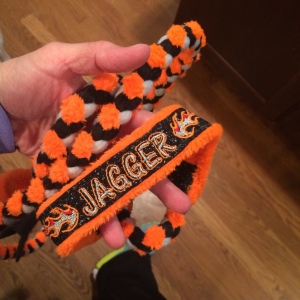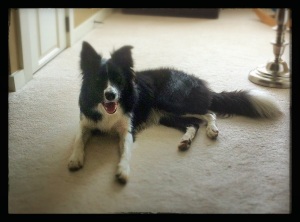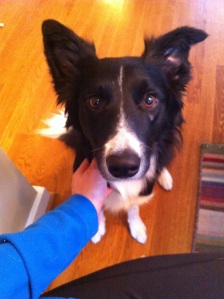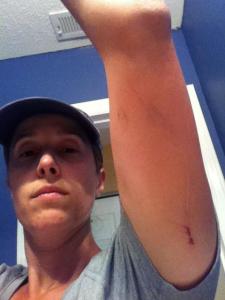One aspect of training running contacts is that it does require regular access to a full size dogwalk. I retrained Copper from 2-on/2-off without regular access to a dogwalk and it was more difficult – I couldn’t get a stable setup with a plank and a table taller than about 16 inches, and then had to go right to full height dogwalk in classes. I’ve never been completely happy with Copper’s dogwalk performance. There are several reasons for that, but one of them is probably the training setup we used. Copper at least had been on a competition height dogwalk plenty of times before, but as Jagger was starting with a blank slate, I knew I wanted to have a better setup, and I wanted a different end result in terms of obstacle performance. I also live too far away from any of the area training fields to make rental a feasible option.

Dog’s eye view
Originally, I had an order in for a commercially made, aluminum framed, rubber surface dogwalk. But, right around the time I came up on the waiting list I also found out I was pregnant with my first child (yay!). Given that news and all the baby stuff we were going to have to buy in the not-too-distant future along with an urgent need to move to a bigger house, dropping a couple grand on a new dogwalk suddenly wasn’t in the budget. Fortunately, there are other options for the economy-minded. After some research, I decided to buy a PVC frame kit from Affordable Agility which could be built at 36″ or 48″ heights. This would also require me to furnish my own planks, which I decided to surface with a rubber pellet kit from Contact-A-Coat. It took me a few weekends, mostly in waiting for paint to dry and resin to cure, but it was pretty easy with a garage to work in out of the weather and some basic tools (screwdriver, drill, hammer, paint roller and tray, containers for staging rubber pellets, nitrile gloves to protect my hands, old sheets to protect the floor). Here are the materials:
- PVC base kit (http://www.affordableagility.com/dogwalkbases.htm) – $344.75 including shipping
- 12′ x 12″ x 1″ wood dimensional lumber board (not pressure treated, those are too heavy) from Lowe’s Home Improvement, 3 @ ~$18/ea- ~$60
- Valspar exterior latex primer, 1 gallon – ~$15 (the sales guy really tried to convince me that the paint/primer combo was the way to go but I wanted as much protection for the wood as possible from rot, and while it’s affordable paint, I don’t find the coverage from Valspar paint at Lowe’s to be that great without several coats)
- Valspar exterior semi-gloss latex paint, 1 gallon – ~$30 (you could probably go even cheaper by buying a “oops” color, but none were available the day I went)
- Dogwalk combo kit (http://www.contactacoat.com/contactacoat-kits/combo-kits/) – $190.20 including shipping
- Finishing nails to hold gum rubber slats in place during curing – ~$1.50
- CMU blocks for heights lower than 36″, 12 @ $1.50/ea – ~$20
Total cost: $661.45
Let’s call that roughly $675 compared to the roughly $2,000 I was looking at for an aluminum dogwalk with a pre-made rubber skin, which doesn’t even include shipping. It’s not going to last forever, and you have to be a little creative to do height adjustments and make sure the equipment is stable on the CMU blocks, but I am really happy with how the equipment turned out.
Here’s what the assembly process looked like:

Bare wood planks, ready for work to start in my garage

Primed
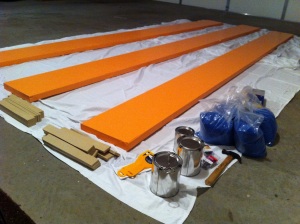
Painted planks with the rubber kit. I could have painted the planks to match the rubber chips for improved appearance, but taping seemed like too much work.

Layout of slats on planks – measure twice, glue once!

Rubber just after application with the resin. Note finishing nails used to temporarily tack down the slats; they had a tendency to slide all over while the resin was wet. My back was killing me after I finished! In retrospect, saw horses would have been a worthwhile side project.

Here is one example of the finished dogwalk (sans hardware) set at 8-inches training height on CMU blocks. Note the small sand bags I used to stabilize the planks on the blocks. The setup worked much better once I had the hinge hardware attached to hold the planks together as it helped get the slight warp out of the boards. Ideally I would have had the hardware installed from the beginning.

Finished dogwalk at 48-inch competition height. The set screws that come with the kit to attach the plank to the PVC frame are *not* long enough and the washers rust, so plan on buying some 3 1/2″ long deck screws and stainless steel washers to finish the project and ensure that the planks are stable. There is about an inch and a half of play on either side of the planks within the PVC supports, and there is a chance it could slip while in use without the screws. Downside of screws is a dog could catch a toe, so also consider covering them with some foam.



